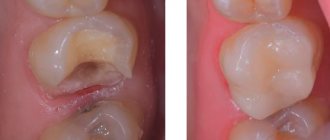Oral syphilis
The diagnosis of “oral syphilis” is based on the patient’s complaints, medical history, clinical examination, and the results of additional research methods. With primary syphilis of the oral cavity, the dentist usually identifies one hard chancre. On palpation, the resulting ulcerative surface is painless, regular rounded, red in color with smooth, raised edges and an infiltrated sebaceous bottom. Lymph nodes are compacted, enlarged, painless, and not fused to the skin and surrounding tissues. With secondary syphilis of the oral cavity, residual syphilomas are found, as well as a roseolous-papular rash on the palate, arches, and tonsils. Scraping the papules leads to exposure of erosive surfaces. In case of relapse of secondary syphilis of the oral cavity, fewer rash elements are formed, papules and roseolas are pale in color, grouped, forming figures resembling garlands and lace.
With secondary syphilis of the oral cavity, polyadenitis is detected. Unlike catarrhal tonsillitis, pain when swallowing and high temperature reaction are not observed with syphilitic lesions. In tertiary syphilis of the oral cavity, a gummous infiltrate is detected, after the disintegration of which a deep crater-shaped ulcerative surface is formed. The integrity of the jaws and nasal bones is compromised. The affected areas become scarred, leading to permanent deformities. There is no enlargement of regional lymph nodes. The detection of treponema pallidum in scrapings or in the contents of lymph nodes confirms the diagnosis of oral syphilis. To identify syphilitic lesions, serological reactions are also used, which in patients become persistently positive, starting from 4 weeks from the moment of formation of chancre. The first 3 weeks of primary oral syphilis are a seronegative period, since at this time it is not possible to confirm the diagnosis using serological reactions.
Radiographically, in patients with tertiary syphilis of the oral cavity, zones of rarefaction of bone tissue in areas corresponding to gummous lesions, as well as sclerotic changes along the periphery, are diagnosed. There is destruction of the cortical bone layer and signs of periostitis ossificans. Oral syphilis is differentiated from a decubital ulcer, a malignant tumor, tuberculous and actinomycotic lesions, tonsillitis, chancriform pyoderma, Setton's aphthae, lichen planus, and leukoplakia. The patient is examined by a dentist or dental surgeon. If a specific syphilitic infection is suspected, the patient is referred for consultation to the dermatovenerological department.
A patient with syphilis visiting a general practitioner
D
I think it is difficult to find anyone among medical workers who has not heard about the current syphilis epidemic. Probably not everyone is familiar with specific indicators. To imagine the scale of this epidemic, it is enough to provide only some figures. Since 1990, the number of newly reported cases of syphilis per 100,000 population has increased rapidly, and the annual series for the period 1989–1997. represented a staircase with giant steps: 4.3–5.4–7.2–13.3–33.8–81.7–177.0–254.2–277.3. The incidence rate has always changed in waves, but we have not seen such a peak as in 1997 for 70 years. Even the post-war maximum rate (115.6) was significantly lower. Let us note that if until the 90s almost all morbidity was registered, which was mainly due to the difficulty and duration of treatment with mandatory hospitalization, now a certain unknown, but certainly significant number of patients are not registered, since outpatient treatment with simplified methods gives wide opportunities for self-medication, treatment from familiar doctors and other ways that do not lead to statistical registration of diseases. According to rough estimates, actual indicators may exceed the recorded ones by 2–3 times.
Primary syphilis (chancre).
Burn chancre with paraphimosis.
Psoriasiform syphilides.
Secondary recurrent syphilis: papules on the palms.
In the last 2 years, the registered incidence began to decrease (in 1998 - by 15%, in 1999 - by 20%). However, even now the Russian average is 186 cases per 100,000 population, and the incidence of syphilis among pregnant women has not yet decreased, which means that there are many children infected in utero. The structure of morbidity is changing: there are more cases of latent syphilis, patients with neurosyphilis are constantly being identified (by the way, early neurosyphilis is not recorded in statistics) - and for a long time, even as the epidemic subsides, damage to the nervous system will appear.
The symptoms of syphilis are varied, and there are many cases of latent, asymptomatic disease.
Identification of patients occurs both when they actively consult a doctor about the symptoms of the disease, and during a preventive serological examination in situations such as stay in a somatic hospital, pregnancy, abortion, childbirth, preparation for surgical interventions, or examination at the place of work. It has long been figuratively noted that “syphilis is like a monkey,” because. copies the symptoms of many other diseases. Therefore, it is quite understandable that patients with syphilis undergo a “pre-diagnostic” examination much more often from doctors of any other specialties than from dermatovenerologists.
Detecting syphilis is our common problem; it concerns every doctor, nurse and midwife. In this case, we are talking not only about the health of the patient, but often about protecting the health of medical workers.
Which specialists and in what typical cases should suspect syphilis in their patient? Let me remind you that syphilis is transmitted in the vast majority of cases through sexual contact, but the infection can also be transmitted through blood transfusion from a sick donor, through the placenta from a sick mother to a child, as well as through close household contacts (sharing a shared bed, hygiene items, etc. ) with patients who have infectious manifestations of the disease on the skin and mucous membranes.
| The incidence of syphilis in Russia is 186 cases per 100,000 population. |
The incubation period of the disease lasts 3–4 weeks; taking treponemocidal antibiotics (penicillins, tetracyclines, macrolides, cephalosporins) for intercurrent diseases can prolong the incubation period to 2–3 months.
The Wasserman reaction in a patient in the incubation period is negative. From the 3rd–4th week, the immunofluorescence reaction (RIF) and ELISA (enzyme-linked immunosorbent assay) may become positive. Infection with syphilis from a person in the incubation period is possible only through blood. Primary syphilis
, a chancre appears at the site of infection
This is the beginning of the primary period of the disease.
A chancre can be a superficial defect on the skin or mucous membrane (erosion) or deeper (ulcer), and it is not necessarily single - multiple are possible. The most characteristic feature of chancre is a dense, cartilage-like consistency infiltrate at its base, which gives rise to the name chancre hard. A week after the appearance of chancre, nearby (regional) lymph nodes enlarge and become denser. Sometimes patients notice enlarged lymph nodes earlier than chancre, and consult a doctor about this. Chancre and regional lymphadenitis
are signs of the first stage of syphilis, which lasts as long as they exist (6–7 weeks).
In most cases, chancre
located
in the genital area
, while the inguinal lymph nodes become enlarged.
Patients who have an idea about sexually transmitted diseases most often turn to the skin and venereal disease clinic with such manifestations, and diagnosis is usually successful. However, uninformed people go to the surgeon
and only see enlarged lymph nodes. I do not remember a case where a surgeon in this situation would risk examining the patient’s genital organ, ask the patient to expose the head of the penis, examine the inner layer of the foreskin, or (totally “blasphemous”) examine the external genitalia of women. The surgeon examines exclusively the place corresponding to his competence - the lymph node - and makes a diagnosis: “banal lymphadenitis” or “lymphadenitis of unknown etiology”. He prescribes an antibiotic, often (unintentionally) treponemocidal, which leads to partial or complete regression of the clinical manifestations of syphilis and transfers it to a latent stage, which, as is known, is more difficult to cure. And sometimes he operates and removes a lymph node. We still encounter linear scars in the groin area in patients with syphilis after removal of lymph nodes.
The situation is even worse when it is not the inguinal lymph nodes that are enlarged, but the cervical and submandibular lymph nodes. This often happens in young girls who become infected with syphilis through oral sex. Teenage girls often begin their sexual contacts with him with the underlying thought of preserving physiological virginity and avoiding pregnancy. With this route of infection, chancre
is located on
the oral mucosa
, often in the area of the tonsils, and may resemble lacunar tonsillitis (ulcerative chancre) or an exacerbation of chronic tonsillitis (atypical non-ulcerative chancre - amygdalitis, with a sharp enlargement of the tonsil).
A girl can get an appointment not only with a surgeon, but even more often with a therapist
, and sometimes
with a hematologist or otolaryngologist
. If you do not keep in mind the possibility of syphilis and do not take blood for serological tests, syphilis in the first stage remains undetected and, perhaps, its course will be distorted by the inappropriate use of antibiotics. So, if you have a young girl at your appointment who you wouldn’t risk giving oral sex to, don’t ask anything and refer the patient to donate blood for RV.
Another stumbling block in primary syphilis is an atypical chancroid in women in the form of indurative edema
, resembling bartholinitis, without ulceration, but with a significant enlargement of one of the labia and a sharp change in its color to purple-bluish.
I know cases where gynecologists
, without examining for syphilis, prescribed antibiotics, opened the “abscess” and, not receiving pus, opened it again. Rule out syphilis! Quickly, efficiently, because in this situation time is of the essence. Test the microprecipitation reaction with blood from your finger - you will get an answer in 20 minutes.
Another type of chancre that makes you think about surgical treatment is anal chancroid in homosexual men.
. Recently, the proportion of men infected through homosexual contact has increased (up to 10–15%). The anal chancre is extremely similar to a fissure: it is located deep in the anal fold, has a “rocket-shaped”, elongated outline, its base is not infiltrated, and the regional lymph nodes located in the pelvic cavity are inaccessible to observation. Unlike chancre in other locations, the anal chancre is painful. It's easy to make a mistake. I have seen patients undergoing surgery in whom the results of seroreactions were reviewed only after surgery. In addition, the operating surgeon may become infected, especially if he does not think about the danger.
Secondary syphilis
There is even more confusion with the diagnosis of secondary syphilis, or the second stage of syphilis, because it is much more diverse and multifaceted in symptoms. As a rule, the chancre has not yet had time to heal, and the lymph nodes are still enlarged when the infection generalizes. Hematogenous contamination with treponema leads to a profuse rash on the skin
.
This is where secondary syphilis begins: the infection is no longer local, but generalized, and its manifestations can occur in any part of the body. The secondary period of syphilis can last up to 3–4 years, and periods with clinical symptoms are replaced by a latent course, and then a relapse of clinical manifestations occurs again. With each relapse, the number of elements decreases, each of them is larger, paler in color and more massively infiltrated. At the end of the secondary period, “monorelapses” may also occur, in which the entire clinic is limited to one single element.
The duration of the first generalized rash in an untreated patient is about 1.5–2 months. The rash is most often located on the chest, abdomen and sides of the body. Sometimes it is so abundant that it covers the back, limbs, and even the face, where its appearance is very rare. The rash is bright, small, the elements do not merge with each other. There is no itching or peeling. Your health suffers little, although sometimes your temperature may rise. The rash is most often spotty
, the elements are pink, do not rise above the surrounding skin and disappear when pressed. It is good if the occurrence of such a rash leads the patient to a dermatovenerologist.
the local doctor deals with this
, the thought of which can have two directions: childhood infection (measles, rubella) or allergies.
In the first case, an infectious disease specialist
, who, as a rule, confirms the diagnosis: after all, most of today’s young people did not have measles (rubella) in childhood; the more severe the course of the present infection is expected. The infectious disease specialist becomes alert only after 2-3 weeks, when the rash, instead of disappearing, continues to bloom. The life experience of some infectious disease specialists is enough to prescribe a blood test for seroreaction. Others do not do this, and “measles” remains “measles,” and the detection of syphilis occurs at some later stage, when the prognosis for cure is no longer so optimistic. If an “allergy” is established, much depends on the persistence and awareness of the patient himself.
However, the rash of the secondary fresh period is not always spotty: it can be nodular, and this usually leads the patient to a dermatologist, and then a venereologist. A small pustular rash with its papulo-crusts and a large abundance of eruptive elements successfully imitates chickenpox. The patient is left without treatment until the absence of regression of the rash in all conceivable periods for chickenpox arouses the concern of the treating infectious disease specialist. And sometimes the patient simply stops coming in, the rash eventually resolves, and syphilis enters the latent stage.
In patients with alcoholism and drug addiction, the manifestations of secondary syphilis are often malignant: multiple ulcers covered with purulent crusts form on the skin of the face and body. The disease resembles a severe form of pyoderma.
Manifestations of secondary syphilis with relapses of rashes
very diverse, they are usually local, i.e.
are located in certain areas of the skin and mucous membranes. Rashes on the oral mucosa
usually force you to see
a dentist
. These can be whitish oval papules on the tonsils or on the mucous membrane of the cheeks, dark pink, slightly raised round papules on the mucous membrane of the hard and soft palate, on the mucous membrane of the lips. In the corners of the mouth, papular elements covered with crusts often form, and then cracks - jams. The original picture can be represented by the back of the tongue, on which oval areas of bright red color, devoid of papillae, are visible - these are papules of the tongue, and the picture is called the “symptom of a mown meadow”. All oral manifestations are highly contagious, requiring dentists to be very vigilant, both for the benefit of other patients and their own.
One of the most typical, almost pathognomonic manifestations of secondary syphilis is papules on the palms and soles
. They are located on the arches of the feet and in the center of the palms. Usually these are raised formations of a dark red or bluish-red color, sometimes with scales along the periphery. A doctor of any specialty, having noticed such manifestations, should examine the patient for syphilis.
No less typical are characteristic changes in skin pigmentation
and hair lesions in secondary syphilis, which are more common in women. Small oval spots of hypopigmentation appear on the posterolateral surfaces of the neck against the background of slightly hyperpigmented surrounding skin. There may be several spots, or there may be many. This picture was called the “necklace of Venus,” and its medical name was syphilitic leukoderma. The pattern of leucoderma is compared to lace or to the play of sunlight breaking through foliage.
Syphilitic alopecia can be diffuse - hair falls out all over the head, and sometimes they are lost quickly (“in the morning they were left lying on the pillow”), and sometimes slowly - over 1–1.5 months. By the end of this period, the remnants of thinning hair are no longer able to cover the skin. With small focal baldness, the scalp looks like “moth-eaten fur.” Eyebrows and eyelashes also fall out. cosmetologists for hair loss
. There are still cases when cosmetology institutions provide treatment for this without testing the blood for seroreaction.
All external manifestations of syphilis located on the mucous membranes (ulcers, erosions, macerated and eroded papules, pustular elements) - in a word, all elements from which there is at least a scanty discharge are contagious. If you come into contact with them, you can become infected with syphilis if there are entrance gates - microtraumas - on the skin or mucous membrane of a healthy person. The blood of a patient with syphilis is also contagious at any stage, starting from the incubation period, if it is transferred to a healthy person, and not only by blood transfusion, but also in case of injury to the skin or mucous membrane with a needle or instrument that has come into contact with the patient’s blood.
Here it is appropriate to dwell on the possibility of occupational infection of medical personnel
from an untreated patient with syphilis. This can happen during surgery if the surgeon’s hands are injured and the patient’s blood gets into the wound. Cases of infection of pathologists due to hand injuries during autopsies have been described. It is possible for a dentist who has microtrauma on his hands to become infected through contact with infectious manifestations of syphilis on the oral mucosa and with the patient’s blood. A dentist can become infected not only through direct contact with infectious manifestations (ulcers, erosions, erosive papules), but also through instruments and a drill handle that come into contact with similar manifestations located on the lips, on the mucous membrane or in the corner of the mouth.
Gynecologists and midwives are at risk of infection during childbirth from an unexamined woman with a contagious form of syphilis. The blood and discharge of such a woman, as well as the blood and discharge of erosive elements if the child has them, are contagious. If the possibility of such occupational infection has occurred, you should consult with a venereologist about the degree of danger and, on his recommendation, carry out preventive treatment with durable penicillin drugs.
I would also like to talk about rare, perhaps even extraordinary cases, when even medical intuition recedes, but the same routine and, unfortunately, not always timely blood test for the Wasserman reaction solves the problem. For the rest of my life I will remember the pale, bloodless face of a 50-year-old woman who was so weak that she was brought to us for a consultation from an oncology hospital literally on a stretcher. She was treated by oncologists and diagnosed with tongue cancer. Two massive courses of radiation therapy had already been carried out, after which severe anemia developed, intensified by uterine bleeding. The patient was offered a radical operation to remove the tongue and all nearby lymph nodes, because even histologically the diagnosis was confirmed... Fortunately, the patient refused the operation.
The sharply positive RV results did not bother anyone: they, of course, were considered false positive... However, during examination in our clinic, the patient was found to have roseola elements on her torso, papules of the genitals, and dissolving papules of the tongue. Diagnosis: secondary syphilis. There is a history of casual sexual intercourse once over many years. The healing progressed slowly, hematologists nursed the patient for more than a year and observed the patient for more than 3 years. The outcome is favorable. It is clear that even oncologists
, so far, it would seem, from venereology, we need to remember this disease from time to time.
We also received 2 young women from oncologists in approximately the same situation: symptoms and diagnosis of stomach cancer, and on the eve of the operation positive RV results came back. In both cases, we also diagnosed secondary syphilis, and specific treatment quickly freed the women from both the symptoms and the terrible diagnosis. Both had specific gastritis
, accompanied by the formation of an infiltrate in the wall of the stomach, which was mistaken for a cancerous tumor.
We also ask you to be attentive to the examination for RV by neurologists
, especially in hospitals, where young patients are admitted with various symptoms, often developing as a stroke.
The disease may turn out to be early neurosyphilis
. Now these cases have increased due to the general increase in incidence. In these cases, neurologists in Moscow and the Moscow region can contact the Central Scientific Research Institute of Medical Sciences, the author of the article, or other employees of the syphilidology department. We are treating these patients together with the Clinic of Nervous Diseases of the Moscow Medical Academy named after I.M. Sechenov. Neurologists in other regions should contact local dermatovenerologists. In this case, it is not necessary to discharge a seriously ill patient (for example, with paraparesis) from a neurological hospital as soon as a positive result of serological tests is obtained. He should be consulted by a dermatovenerologist and receive treatment on the spot, since within a day after the start of antibiotic therapy he will be epidemiologically harmless. If you need our advice, you can get it by calling (095)964–09–94.
In conclusion, I would like to once again remind doctors of all specialties: a patient with syphilis could knock on the door of any of you tomorrow. Consider this as good luck, since the patient can be cured. And the first thing to do is a blood test for the Wasserman reaction.
How does syphilis manifest?
Symptoms of syphilis vary depending on the time that has passed since infection. The first typical symptom: the primary lesion, that is, painless ulceration, which may be accompanied by enlargement of the surrounding lymph nodes. This change occurs approximately 3 weeks after infection and lasts from 2 to 6 weeks. In women it is most often located on the labia or cervix, and in men it is most often located on the penis, anal canal or mouth. Due to its specific location, this lesion is sometimes confused with herpes or goes unnoticed.
When spirochete bacteria multiply on the body, a so-called macular rash occurs, which takes the form of spots, papules or pustules, most often on the torso or upper arms. Over time, it can affect the arms and legs, including the inside of the feet, scalp, and face. These changes do not cause itching and last on the skin for several weeks.
Syphilis can cause very uncharacteristic symptoms that are more often associated with other diseases and are therefore underdiagnosed. The disease may be accompanied by fever, a feeling of loss of strength and fatigue, headaches and muscle pain, periodic erosions in the mouth, weight loss or hair loss.
At an advanced stage, syphilis can lead to serious, life-threatening complications. Reproducing bacteria damage internal organs, including the circulatory system and the motor system, which affects the deterioration of mobility. The disease also affects the nervous system, which can lead to personality disorders or mental disorders.
Neurosyphilis
Syphilis is a sexually transmitted infectious disease caused by Treponema pallidum.
Pathogen
The causative agent of syphilis is Treponema pallidum, which belongs to the order Spirochaetales, family Spirochaetaceae, genus Treponema. Morphologically, treponema pallidum (pale spirochete) differs from saprophytic spirochetes (Spirochetae buccalis, Sp. refringens, Sp. balanitidis, Sp. pseudopallida). Under a microscope, Treponema pallidum is a spiral-shaped microorganism that resembles a corkscrew. It has on average 8-14 uniform curls of equal size. The length of the treponema is 7 - 14 microns, thickness 0.2-0.5 microns. Treponema pallidum is characterized by pronounced mobility, in contrast to saprophytic forms. It is characterized by translational, rocking, pendulum-like, contractile and rotatory (around its axis) movements. Using electron microscopy, the complex morphological structure of Treponema pallidum was revealed. Treponema is covered with a thick covering of a three-layer membrane, a cell wall and a mucopolysaccharide capsule-like substance. Under the cytoplasmic membrane there are fibrils - thin threads that have a complex structure and cause diverse movement. Fibrils are attached to the terminal turns and individual sections of the cytoplasmic cylinder using blepharoplasts. The cytoplasm is finely granular, containing a nuclear vacuole, nucleolus and mesosomes. It was established that various influences of exo- and endogenous factors (in particular, previously used arsenic preparations, and currently antibiotics) had an impact on Treponema pallidum, changing some of its biological properties. Thus, it turned out that pale treponema can turn into cysts, spores, L-forms, grains, which, when the activity of the patient’s immune reserves decreases, can reverse into spiral-shaped virulent varieties and cause active manifestations of the disease. The antigenic mosaic nature of pale treponema is proven by the presence in the blood serum of patients with syphilis of multiple antibodies: protein, complement-fixing, polysaccharide, reagins, immobilisins, agglutinins, lipoids, etc. Treponema in the lesions is often located in intercellular spaces, periendothelial space, blood vessels, nerve fibers, especially in early forms of syphilis. The presence of pale treponema in the periepineurium is not yet evidence of damage to the nervous system. More often, such an abundance of treponemes occurs during septicemia. During the process of phagocytosis, a state of endocytobiosis often occurs, in which treponemes in leukocytes are enclosed in a multimembrane phagosome. The fact that treponemes are enclosed in polymembrane phagosomes is a very unfavorable phenomenon, since, being in a state of endocytobiosis, treponema pallidums persist for a long time, protected from the effects of antibodies and antibiotics. At the same time, the cell in which such a phagosome has formed seems to protect the body from the spread of infection and progression of the disease. This precarious balance can persist for a long time, characterizing the latent (hidden) course of a syphilitic infection.
Epidemiology
The disease occurs systemically from the very beginning, affecting various organs and structures, including the nervous system, and in the absence of adequate treatment becomes chronic, often asymptomatic.
The peak incidence occurred at the end of the 19th - beginning of the 20th century, and cases of neurosyphilis by our time have gradually become so rare that they have practically ceased to be encountered in the daily practice of neurologists. Over the next 3–4 decades, an opinion has developed not only about the great rarity of neurosyphilis, but also about the predominance of its low-symptomatic, erased forms.
The incidence of all forms of syphilis increased more than 60-fold from 1989 to 1996. In 1997, there were signs of stabilization at a high level (the incidence was 277.3 cases per 100 thousand population, which exceeds the 1996 figure by only 4%).
Against the background of such an increase in the incidence of syphilis, one could expect an increase in the number of cases of neurosyphilis, which is what happened starting in 1995.
Pathogenesis
The reaction of the patient's body to the introduction of Treponema pallidum is complex, diverse and insufficiently studied. Infection occurs as a result of penetration of Treponema pallidum through the skin or mucous membrane, the integrity of which is usually compromised. At the same time, it is known that in the blood serum of healthy individuals there are factors that have immobilizing activity against Treponema pallidum. Along with other factors, they make it possible to explain why infection is not always observed upon contact with a sick person. Thus, an important pathogenetic factor in the occurrence of syphilis is the state of the immune system, the tension and activity of which varies depending on the degree of virulence of the infection. Therefore, not only the possibility of no infection is being discussed, but also the possibility of self-healing, which is considered theoretically acceptable.
The incubation period is 20-40 days from the moment of infection until the appearance of chancre.
Course of syphilis
Syphilis is divided into primary, secondary, latent and tertiary. Primary syphilis begins with the appearance of a chancre and continues until it heals or a rash appears. Secondary syphilis is characterized by a variety of skin manifestations. Latent syphilis (early and late) has no clinical manifestations, but serological tests are positive. Tertiary syphilis is characterized by various manifestations (the appearance of gummas is characteristic)
Forms of neurosyphilis
The development of neurosyphilis is possible at any stage of syphilis, except primary. The manifestations of neurosyphilis vary depending on the time that has passed since infection. Manifestations of early (usually in the first 5 years of infection) and late neurosyphilis are possible (clinical manifestations develop 10-17 years after infection).
Early neurosyphilis
In early neurosyphilis, the process is localized mainly in the vessels and membranes of the brain and spinal cord. Manifestations of early neurosyphilis include: early meningovascular form (cerebral and spinal manifestations), symptomatic and asymptomatic meningitis, myelitis, vasculitis.
Syphilitic meningitis. There are three forms of syphilitic meningitis: asymptomatic meningitis, acute and chronic. Asymptomatic syphilitic meningitis occurs in patients at the beginning of the secondary period of syphilis and depends on the primary penetration of Treponema pallidum into the nervous system. The entry of treponemas into the meninges leads to the development of inflammatory perivascular lymphocytic infiltration and the proliferation of fibrous tissue in the meninges. Patients complain of headaches and irritability. There are no objective signs of damage to the nervous system in most patients. The diagnosis is possible only by examining the cerebrospinal fluid, which reveals lymphocytic pleocytosis (tens, less often hundreds of cells), a slight increase in the amount of protein, and a positive Wasserman reaction. Acute syphilitic meningitis is also a manifestation of secondary syphilis. The introduction of Treponema pallidum in these cases leads to the development of an exudative-proliferative process mainly at the base of the brain along the vessels and perineural spaces of the cranial nerves. The disease develops acutely. The temperature rises to 38-39. Severe meningeal syndrome is observed. Focal inflammatory changes may appear. Chronic syphilitic meningitis is the most common manifestation of secondary syphilis, caused by the development of a chronic inflammatory process in the soft (leptomeningitis) and hard (pachymeningitis) membranes of the brain and spinal cord. The inflammatory process, as in acute syphilitic meningitis, is localized in the membranes at the base of the brain, and along the vessels penetrates into the substance of the brain and spinal cord (meningo-encephalitis, meningomyelitis). A characteristic sign of chronic syphilitic meningitis is damage to the cranial nerves, most often the oculomotor (paralysis of the external and internal muscles of the eye, strabismus, ptosis, diplopia, Argyle-Robertson syndrome), optic (neuritis and congestion), olfactory, trigeminal and vestibular nerves. The course is chronic or subacute with remissions and exacerbations.
Syphilitic vasculitis is detected more often during the first years after the onset of the disease. The medium and large arteries of the base of the brain are thickened, their adventitial and muscular membranes are infiltrated with lymphocytes, the internal membrane grows, foci of granulation tissue form and the lumen gradually closes (Gubner endarteritis). Scattered miliary gummas are found in the walls of blood vessels. Headaches, irritability, and repeated cerebrovascular accidents such as hemorrhage (in the brain or subarachnoid) or softening develop. Characteristic signs of cerebral circulatory disorders due to vasculitis are their recurrence, multifocality and a tendency to rapid recovery even without specific treatment.
The neurological picture is determined by the localization of the lesion. In the vessels of the spinal cord, the process is most often localized in the region of the terminal branches of the anterior spinal artery. In the cerebrospinal fluid, small (6-20 cells per 1 mm) lymphocytosis and an increase in protein (0.6-1%) are detected (only in the early stages of the disease). The Wasserman reaction in this form of neurosyphilis in the blood and cerebrospinal fluid is sharply positive.
Late neurosyphilis
With late neurosyphilis, the nervous tissue is mainly affected at its various levels. Parenchymal, late forms include: tabes dorsalis, progressive paralysis, gummas of the brain and spinal cord, myatrophic spinal syphilis, spastic Erb's palsy.
Late syphilitic meningitis and late vascular forms are also possible.
dorsalis ( tabes dorsalis ). The incubation period ranges from 5 to 50 years, with an average of 20 years. Tabes dorsalis is based on inflammatory infiltration and degeneration of the dorsal roots in the area of their entry into the spinal cord and the posterior cords of the spinal cord. Characteristic symptoms are shooting radicular pains (up to tabetic pain crises), disorders of deep sensitivity with loss of deep reflexes and sensitive athexia, neurogenic disorders, impotence. Argyll Robertson syndrome is detected, neurogenic arthropathy (Charcot's joint), and trophic ulcers on the lower extremities are not uncommon. All these symptoms may remain after antibiotic therapy.
Progressive paralysis is a late manifestation of infection, usually developing 10-20 years after infection. It is an encephalitic form of neurosyphilis associated with the direct penetration of treponemes from the perivascular spaces into the brain cells, and is manifested by slowly increasing impairment of cognitive functions with personality changes up to the development of dementia. Manic and depressive states, delusions, and hallucinations are often encountered. The disease progresses steadily, leading to death over several months or years. Signs of progressive paralysis and tabes dorsalis can be combined, in such cases taboparalysis is diagnosed.
Syphilitic gumma can be localized in the area of the basal liquor cisterns and lead to compression of the cranial nerves at the base of the brain. The clinical picture resembles signs of a space-occupying brain lesion with progressive intracranial hypertension. Sometimes gumma is localized in the spinal cord, causing increasing lower paraparesis, parahypesthesia, and dysfunction of the pelvic organs.
Erb's spastic palsy is characterized by gradually progressive paresis of the lower extremities with increased muscle tone, tendon reflexes, foot clonus, pathological reflexes, but without significant pelvic, sensory and trophic disorders. Spastic phenomena prevail over paretic ones. The upper limbs are usually not involved in the process.
Meningovascular neurosyphilis. The meningovascular form of neurosyphilis develops with damage to small vessels due to the development of endovascularitis with perivascular inflammation. The vessel develops intimal proliferation, thinning of the media, inflammatory changes in the adventitia with infiltration of lymphocytes and plasma cells. Gradual narrowing of the lumen predisposes to the development of thrombosis and blockage of the vessel. The meningovascular form manifests itself on average 5-7 years after infection and manifests itself as an ischemic stroke in young patients.
Treatment
The most effective is intravenous administration of high doses of penicillin (2-4 million units 6 times a day) for 10-14 days. If you are allergic to penicillins, use ceftriaxone (Rocephin) 2 g per day intravenously or intramuscularly for 10-14 days. It is also possible to use erythromycin and tetracycline. Along with antibacterial therapy, syndromic therapy is carried out.










